|
Rabbit Vet Care in Gilbert AZ
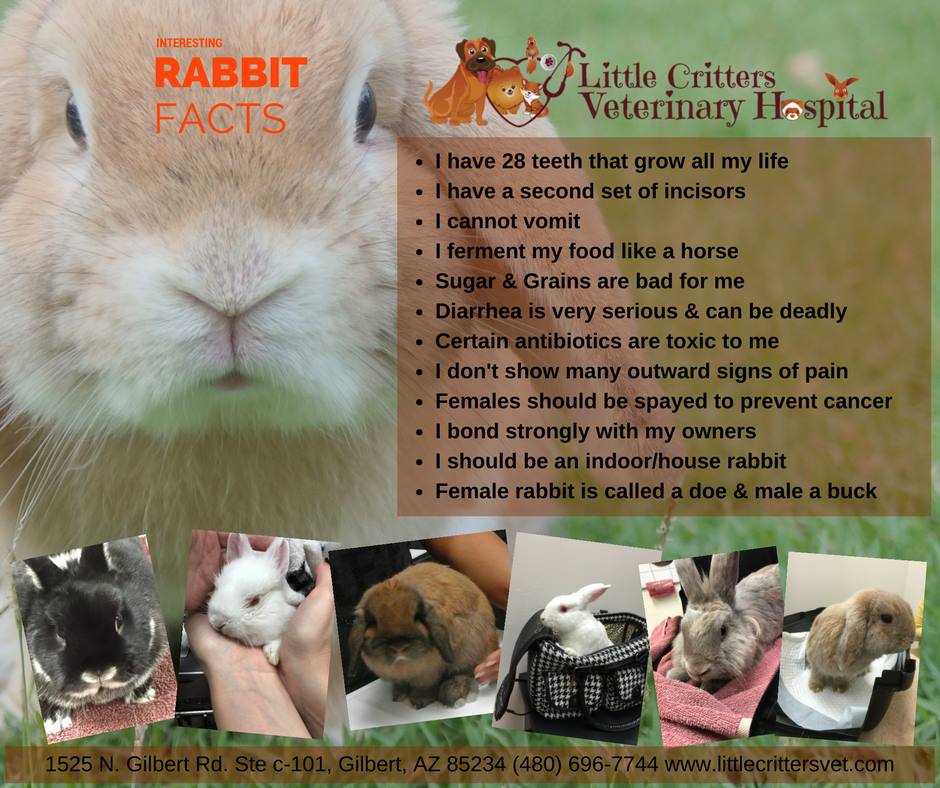
|
INTRODUCTION: RABBIT INFORMATION
Rabbits make wonderful and affectionate house companions, and I wholeheartedly recommend them for this purpose. They offer several advantages, such as being easily trainable for litter box use and adapting to using a doggie door. With proper care, rabbits can enjoy a long and fulfilling life. These furry friends are quite popular as indoor pets, and you'll find numerous clubs and online organizations dedicated to their well-being, which I'll provide links to on this page.
However, like all exotic pets, rabbits have specific requirements to ensure their health and happiness. It's highly advisable to have your pet rabbit sterilized to prevent potential issues in the future. Unneutered male rabbits can be prone to aggressive behavior, often resulting in injuries that require surgical intervention. They may also pose challenges in litter box training due to their tendency to mark their surroundings with feces and urine.
Similarly, intact females can be challenging to litter box train, and if left unspayed throughout their lives, they face an increased risk of developing uterine cancer as they age. If your intention is to have a rabbit as a house pet, and your furry friend is in good health, there's really no compelling reason not to spay or neuter them.
|
RABBIT SURGERY / ANESTHESIA:
Before any anesthesia procedure, it is essential to conduct a comprehensive physical examination and pre-anesthetic blood tests on all animals to detect any preexisting organ diseases. For young animals that have undergone proper screening, the associated risks are minimal. Following any stressful event, such as surgery, anesthesia, pain, illness, or environmental changes, it is crucial to observe your pet's appetite and fecal production.
I advise my clients that one of the most valuable indicators of a rabbit's health is their feces. Healthy rabbits typically maintain a consistent appetite throughout the day and produce well-formed, round fecal pellets of normal size. However, rabbits under stress may occasionally stop eating or defecating altogether. In such cases, you might notice that the fecal pellets are smaller than usual or absent entirely. If you observe these changes, it's a serious and potentially life-threatening condition that requires immediate attention.
As veterinarians, one way we can help mitigate this risk is by providing pre- and post-surgical pain management to reduce stress on your bunny. At home, if you notice a decrease in fecal output or a change in appetite, it's crucial to contact your veterinarian promptly. Typically, we will attempt to adjust pain management, and if your rabbit still isn't eating, we often introduce syringe feeding for a short period to stimulate their gastrointestinal tract. The syringe formula typically includes a mixture of grass hay pellets, water, and vegetable baby food.
Additionally, it's vital to ensure your bunny receives an ample amount of fiber to maintain proper gut function, which will be further discussed in the dietary section. My intention is not to deter you from elective or necessary surgeries but to inform you about potential issues so that your bunny receives proper monitoring and care after surgery. The advantages of spaying and neutering your bunny far outweigh the minimal risks involved.
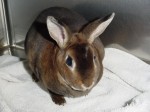
SUMMARY:
- PET RABBITS SHOULD BE SPAYED OR NEUTERED
- THERE IS ALWAYS A RISK WITH ANY SURGERY/ANESTHESIA
- MINIMIZE RISK WITH PROPER SCREENING PRIOR TO SURGERY
- MINIMIZE RISK WITH PROPER POST-SURGICAL CARE AND MONITORING
|
|
Grooming:
Effective grooming is a cornerstone of proper rabbit care, encompassing various crucial components. It's a routine that contributes significantly to your furry friend's overall well-being. Here, we'll delve into the key aspects of grooming and why they matter.
1. Daily Brushing:
- Importance: Daily brushing plays a pivotal role in your rabbit's grooming routine. It serves multiple purposes, including the removal of loose fur and the reduction of hairball risk, which can be a significant concern for rabbits.
- Hairball Risk: Rabbits are meticulous groomers, but their grooming habits can lead to the ingestion of fur. Daily brushing helps mitigate this risk by capturing loose fur in the brush, preventing it from accumulating in their gastrointestinal tract.
2. Nail Trimming:
- Why It Matters: Trimming your rabbit's nails is a key aspect of grooming, ensuring their comfort and foot health. Rabbit nails are naturally sharp and cannot be dulled entirely due to their unique structure. Overgrown nails can lead to discomfort and mobility issues.
3. Dental Health:
- Clarification: While some may consider teeth trimming as part of grooming, it's crucial to clarify that it's typically necessary only in cases of dental disease, such as malocclusion. Dental issues require specialized medical care and should not be considered routine grooming.
4. Bathing Considerations:
- Avoiding Unnecessary Stress: In general, bathing is not recommended for healthy rabbits. These animals are adept at self-cleaning, and daily brushing is usually sufficient to help them maintain cleanliness.
- Stress Factor: Bathing can be highly stressful for rabbits, especially those with dense fur. Furthermore, ensuring thorough drying down to the skin after a bath can be challenging, potentially leading to skin problems.
5. Preventing GI Stasis:
- Hair Ingestion Risk: Rabbits are prone to ingesting fur during grooming, which can contribute to gastrointestinal (GI) stasis, a condition where their digestive system slows down or becomes obstructed.
- Role of Brushing: Regular brushing helps minimize the risk of hair ingestion, which, in turn, reduces the likelihood of GI stasis. Coupled with a high-fiber diet, it's a crucial component of maintaining your rabbit's digestive health.
In summary, grooming is not merely about keeping your rabbit looking clean; it's about ensuring their comfort, health, and well-being. Daily brushing, nail trimming, and dental care (when necessary) are essential elements of this routine. While bathing is generally discouraged for healthy rabbits, preventive measures against hair ingestion through brushing are crucial. Understanding the significance of grooming helps you provide the best care for your furry companion and minimizes potential health issues down the road. If you observe any changes in your rabbit's grooming habits, appetite, or fecal output, don't hesitate to consult your veterinarian for guidance and timely intervention.
|
Summary:
- Rabbits need daily brushing
- Bathing is not needed or recommended
- Rabbits require regular nail trims
- Over grown teeth is often a medical problem
- Flea and mite control may be needed
- Over the counter flea control is not recommended
- Revolution has proven to be safe to rabbits.
- Frontline should not be used on rabbits
|
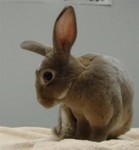
|
|
|
HOUSING:
|
The most effective way to provide housing for a rabbit involves a combination of litter box training and carefully rabbit-proofing your home. This approach allows your furry friend to interact with the family and enjoy a safe and comfortable living environment. However, when left unsupervised, it's advisable to confine them to prevent any potential house damage (as rabbits have a tendency to dig and chew on items like carpet) and ensure their safety.
It's crucial to emphasize that rabbits should never be housed in cages with wire-bottom surfaces. Over time, this can lead to sore feet and even foot wounds, causing unnecessary discomfort for your pet. Instead, opt for the largest cage that fits your budget and space, featuring a solid surface bottom. To line the cage, you can use newspaper or straw.
|
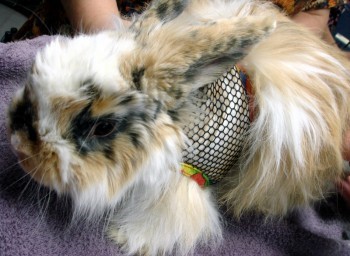
|
To enhance your rabbit's living space, consider adding some essential elements:
- Hay Manger: Furnishing the cage with a hay manger is a good idea as it encourages proper nutrition. However, exercise caution, as startled rabbits can potentially get their feet or legs trapped in a wire manger.
- Litter Box: Provide a litter box within the cage, filled with suitable litter material like newspaper pellets or straw. It's worth noting that some believe pine shavings may be toxic to rabbits, so it's advisable to avoid using them.
- Water Source: Rabbits require a consistent source of water. Using a water bottle is usually the best method, as it prevents them from getting their fur wet while drinking.
Maintaining a clean environment is essential for your rabbit's health and well-being. Therefore, it's recommended to clean the cage daily, ensuring a comfortable and hygienic living space for your beloved pet.
Summary:
- Keep pet rabbits indoors
- Rabbit proof your house
- Litter box train your rabbit
- Cage when unsupervised
- Don’t use wire bottom cages – they will get sore feet
- Have a constant source of hay and water available
- Include a litter box in the cage
- Avoid pine & cedar shaving as a source of litter
|
-
Optimal Nutrition for Rabbits: A Comprehensive Guide
Rabbits have an exceptionally delicate gastrointestinal (GI) tract, and the foundation of their well-being lies in a carefully planned diet. Numerous health issues in rabbits can be traced back to a poor diet that disrupts their GI function. To ensure the best possible care for your rabbit, it's crucial to provide them with the right foods and understand the principles of a balanced diet.
1. Essential Role of Grass Hay:
- The Gold Standard: The cornerstone of a rabbit's diet is grass hay, and not just any hay, but "grass" hay. Alfalfa hay, although a type of hay, is much too rich for rabbits, being exceptionally high in calcium, which can lead to urinary problems.
- Ideal Hay Choices: Opt for grass hays like Bermuda or timothy, which are rich in fiber. Hay is a nutritional powerhouse, aiding in maintaining a normal GI tract, promoting healthy chewing activity, and assisting in proper tooth wear.
2. Leafy Greens as Daily Delights:
- Crucial Greens: In addition to hay, your rabbit should enjoy a variety of leafy greens daily. These greens not only diversify their diet but also provide essential nutrients. Spring greens, which can often be found prepackaged, are an excellent choice.
- Healthy Greens: Consider including the tops of most veggies, parsley, kale, and collards in their diet. However, it's essential to avoid iceberg lettuce, as it lacks nutritional value.
3. Balanced Pellets as a Supplement:
- Role of Pellets: While hay and leafy greens form the core of your rabbit's diet, grass hay-based pellets can be offered as a supplementary source of nutrition. The recommended serving size is approximately 1/4 cup per 5 pounds of body weight daily.
- Not a Hay Replacement: It's vital to understand that pellets should not replace hay but complement it, ensuring a well-rounded diet.
4. Foods to Steer Clear Of:
- Grains and Sugars: One of the essential rules in rabbit nutrition is to avoid foods rich in grains and sugars. These can lead to obesity or diarrhea and should be excluded from their diet.
In conclusion, the foundation of a healthy rabbit diet is grass hay, with Bermuda and timothy being excellent choices. Daily leafy greens and a small serving of grass hay-based pellets provide variety and necessary nutrients. Conversely, alfalfa hay is not suitable for rabbits due to its high calcium content. By adhering to these dietary guidelines, you can help prevent numerous diseases associated with improper nutrition.
|
GASTROINTESTINAL TRACT:
Maintaining Healthy GI Health in Rabbits: A Closer Look
From the preceding discussion, it's evident that gastrointestinal (GI) health is a paramount concern when it comes to rabbits. Rabbits, in many ways, resemble miniature horses in their susceptibility to colic and GI issues, which can arise seemingly at the slightest provocation. However, the key to managing GI problems in rabbits lies in prevention through a well-balanced diet. Let's delve deeper into some of the common GI issues in rabbits and how to address them.
1. Common GI Problems:
- Diarrhea: Diarrhea is a prevalent GI issue in rabbits. It manifests as the abnormal consistency of all feces produced and can lead to fecal staining around the rectum and tail.
- Anorexia: Anorexia, or a loss of appetite, is another concern. Rabbits are notorious for their sensitive appetites, and any prolonged refusal to eat is a serious matter.
- Gut Stasis and Lack of Fecal Production: Gut stasis, characterized by a slowdown or cessation of the digestive process, is a particularly worrisome condition. It can lead to a lack of fecal production and severe discomfort for your rabbit.
2. Seeking Veterinary Care:
- Prompt Attention: If you notice any of these problems in your rabbit, it's imperative to seek prompt veterinary care. Your veterinarian will assess your pet's specific condition and direct the appropriate treatment.
3. Understanding Normal GI Function:
- Cecotropes: It's important to recognize the normal aspects of a rabbit's GI function. Rabbits produce a unique type of feces called cecotropes. These partially digested pellets are stored in their cecum and are passed and consumed by the rabbit about once daily.
- Recycling Nutrients: The ingestion of cecotropes is a natural way for rabbits to recycle B vitamins and essential nutrients. It's a vital part of their digestive process and should not be confused with diarrhea.
- Rich Diets: Some pet rabbits, particularly those fed a rich diet, may occasionally fail to consume their cecotropes. Owners might become concerned, mistaking this for diarrhea. Rest assured, it is not a cause for alarm. True diarrhea is when all feces produced have an abnormal consistency.
4. Harmlessness of Cecotrophs:
- No Harm Done: If your rabbit occasionally fails to consume its cecotropes, it will not cause any harm. It's a normal part of their digestive process.
In conclusion, GI health is indeed a significant concern for rabbits. However, with the right knowledge and care, many GI issues can be prevented through proper nutrition. If you ever observe signs of GI distress in your rabbit, such as diarrhea or anorexia, consult your veterinarian promptly. Understanding the nuances of normal GI function, including the role of cecotropes, can help you differentiate between normal digestive processes and medical issues. Rest assured, with the right care and attention, you can ensure your rabbit's GI health and overall well-being.
|
Addressing Anorexia and Fecal Production Issues in Rabbits
Anorexia, the refusal to eat, and the absence of fecal production are critical concerns and potential life-threatening issues. Any rabbit displaying these symptoms requires immediate veterinary attention. Treatment typically involves a combination of interventions aimed at restoring their health.
Common Treatment Approaches:
- Fluid Administration: Rabbits in distress are often given fluids to combat dehydration and maintain their overall well-being.
- High Fiber Diet: A high-fiber diet is crucial for promoting healthy gastrointestinal function. It aids in stimulating the digestive process and facilitating fecal production.
- Medications for GI Movement: Medications may be prescribed to enhance GI motility, ensuring that the digestive system functions properly.
- Pain Management: Pain medications may be administered to alleviate discomfort, which can be especially beneficial in cases of GI distress.
Tailored Treatment:
- Individualized Care: The specific treatment regimen will depend on the underlying cause of the rabbit's illness. A veterinarian will diagnose the primary issue and develop a treatment plan accordingly.
Home Care Involvement:
- Pellet Slurry: In some cases, home care plays a crucial role. This can involve preparing a pellet slurry and syringe feeding it to the rabbit multiple times a day until they resume voluntary eating.
In summary, anorexia and the absence of fecal production are alarming signs in rabbits that necessitate immediate veterinary care. Treatment strategies commonly include fluids, a high-fiber diet, medications to support GI function, and pain relief. The precise treatment plan will be tailored to address the root cause of the rabbit's condition. Additionally, home care, such as syringe feeding a pellet slurry, may be part of the recovery process. The key is to act swiftly and decisively when these symptoms arise to ensure the best possible outcome for your beloved pet.
Summary:
- GI disease is a serious problem in rabbits
- Signs of GI disease are decreased appetite and fecal production (small feces or no feces)
- GI disease is often due to a poor diet
- Cecaltrophy is normal in rabbits
- The best rabbit diets are high in grass hay and leafy greens
- All rabbits with GI signs should be examined by a veterinarian
- Home care often involves syringe feeding until eating on their own
|
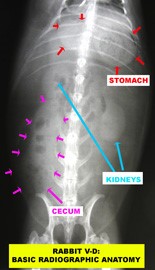
|
|
|
|
Understanding Periodontal Disease in Rabbits
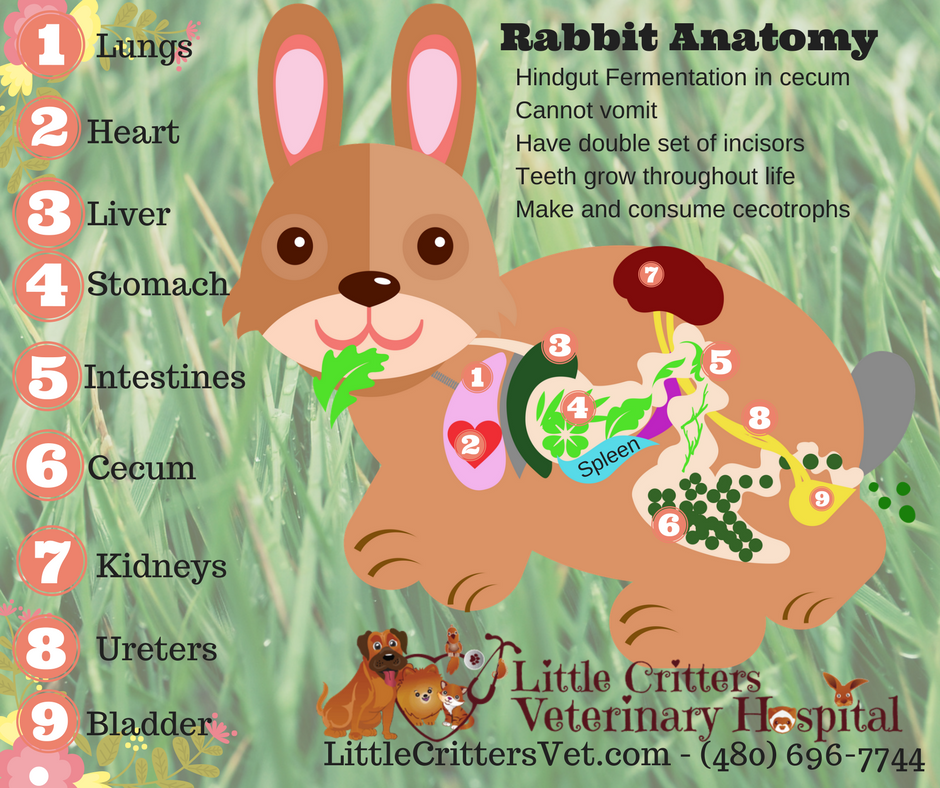
Rabbits possess a unique dental structure where their teeth continue to grow throughout their lifetime. Occasionally, this continuous growth can lead to dental problems. The upper teeth (maxillary) are believed to grow slightly slower than the lower teeth (mandibular), with an estimated rate of growth being approximately 2-3mm per month.
Detecting Malocclusion:
- Spikes and Alignment: Rabbits with malocclusion, a condition where the teeth surfaces are not correctly aligned, can develop spikes on the part of the tooth that doesn't wear normally. These spikes can become significant enough to cause pain due to tongue trauma and may even entrap the tongue, hindering normal eating.
- Irregular Incisors: Owners may notice irregular or angled ends on the incisors (front teeth), which reflects the abnormal alignment of the molars.
Ongoing Veterinary Care:
- Regular Dental Examinations: Rabbits with malocclusion require frequent veterinary attention, often on a monthly basis, to have their molars examined and reshaped. Since rabbit teeth grow continuously, it's vital to ensure they wear down properly.
- Maintaining Tooth Wear: To promote continuous wear, it's beneficial to provide rabbits with hay and toys that encourage chewing and play.
- Annual Check-ups: All rabbits, regardless of dental issues, should undergo a yearly examination, which should include an oral assessment. This allows veterinarians to swiftly inspect the molars, often using an otoscope (ear cone) inserted into the mouth for a thorough view of the occlusional surfaces.
Beyond Teeth:
- Eye and Jaw Signs: Dental disease in rabbits can have broader effects, not limited to the teeth alone. Many rabbits with tooth abscesses may exhibit signs such as tearing eyes, jaw swelling, or swollen (pushed out) eyes. These are indicative of severe dental issues and require comprehensive evaluation, which often includes general anesthesia and x-rays (radiographs).
In conclusion, understanding periodontal disease in rabbits is crucial for their overall health and well-being. With teeth that grow continuously, regular dental examinations and proper tooth wear are essential. Malocclusion can lead to painful spikes and difficulty eating, making consistent veterinary care a necessity. All rabbits, regardless of dental concerns, should undergo annual check-ups, including oral assessments. Keep in mind that dental problems can manifest beyond the teeth, often showing signs in the eyes and jaw, which should prompt further investigation and treatment.
Understanding Periodontal Disease in Rabbits: Detecting Pain
Rabbits' unique dental structure, with continuously growing teeth, can sometimes lead to dental issues such as malocclusion. This condition, where the teeth surfaces do not align correctly, can result in painful spikes on the teeth and difficulty eating. To ensure the well-being of your rabbit, it's vital to be aware of signs of pain and distress, including those exhibited through facial expressions.
Detecting Pain in Rabbits: Rabbit Grimace Scale
- Facial Expressions: Rabbits, like many animals, can exhibit subtle facial expressions that indicate pain or discomfort. These expressions are assessed using a Rabbit Grimace Scale, which helps veterinarians and caregivers recognize signs of pain in rabbits.
- Key Indicators: Some key indicators of pain on the Rabbit Grimace Scale include:
- Tightening of the Eyes: The eyes may narrow or partially close when the rabbit is in pain.
- Cheek Flattening: The cheeks may become flattened, and the whiskers may appear more tightly pressed against the face.
- Nose Changes: The rabbit's nose may appear to change shape, often flattening.
- Ear Positions: Changes in the position of the ears, such as rotating them backward or pressing them flat against the head, can be indicative of discomfort.
Immediate Veterinary Attention:
- Prompt Action: If you observe signs of pain or discomfort in your rabbit, especially those indicated by the Rabbit Grimace Scale, it's crucial to seek immediate veterinary attention.
- Pain Management: A veterinarian can assess the source of the pain and recommend appropriate pain management strategies to ensure your rabbit's comfort.
By understanding and recognizing these subtle signs of pain in rabbits, you can take swift action to address any underlying dental issues or discomfort. Periodontal disease, if left untreated, can significantly impact your rabbit's overall health, so early detection and intervention are essential for their well-being.
|
Cancer Concerns in Rabbits: Prevention and Vigilance
Cancer, while not uncommon in rabbits, is a health issue that can often be addressed or prevented with timely care and attention. Understanding the risks and being vigilant about potential signs is essential for maintaining your rabbit's well-being.
Uterine Cancer and Spaying:
- Risk in Unspayed Females: Female rabbits that remain unspayed are at risk of developing uterine cancer later in life. This serious condition can be entirely prevented through early spaying of your rabbit.
- Preventive Measures: Spaying your female rabbit at a young age significantly reduces the risk of uterine cancer. This is an essential step in safeguarding your rabbit's long-term health.
|
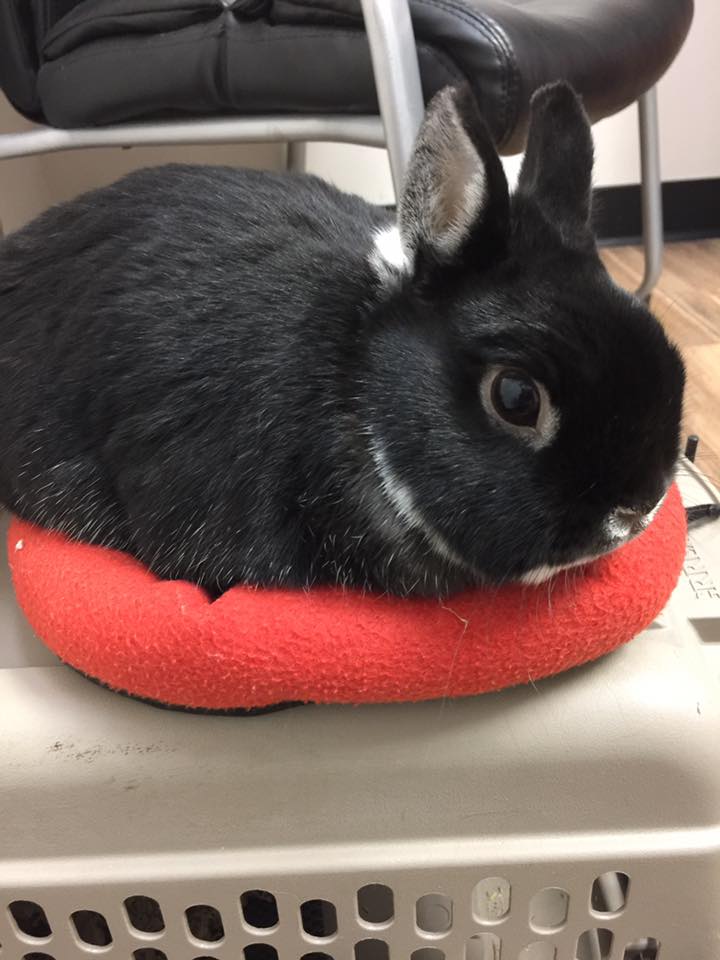
|
Other Types of Cancer:
- Internal and External Concerns: Rabbits can develop various types of cancers, both internally and externally. While some may be visible on the skin's surface as suspicious lumps, it's important to remember that not all skin lumps are cancerous; many are abscesses.
- Vigilance: Any unusual lumps or growths on your rabbit's skin should be promptly examined by a veterinarian. While abscesses are common, it's crucial to rule out the possibility of neoplasia (cancer) through proper evaluation.
- Early Detection: Early detection is key to effectively managing and treating cancer in rabbits. Regular check-ups and vigilance for any changes in your rabbit's skin or behavior are essential for catching potential issues in their early stages.
In conclusion, cancer is a concern for rabbits, but with preventive measures such as spaying and vigilant monitoring of your rabbit's health, you can reduce the risks and ensure prompt intervention if any issues arise. Regular veterinary check-ups are invaluable for detecting and addressing potential health problems, including cancer, in a timely manner, ultimately promoting the longevity and well-being of your beloved pet.
|

|
Combatting Obesity: A Rabbit's Weight Dilemma
Obesity is a condition that can inadvertently affect rabbits, often as a result of improper dietary choices rather than excessive food consumption. Understanding the causes and consequences of obesity in rabbits is essential for promoting their overall health and well-being.
The Role of Diet:
- Grains and Sugars: Obesity in rabbits is frequently linked to dietary choices. Feeding foods rich in grains, such as sweet feed or pellets containing corn, as well as offering high-sugar treats, can contribute to weight gain.
- Obesity-Related Problems: Obesity can lead to various health problems in rabbits, including urinary scalding in females. Excessive fat deposits can enclose the genital area, making it difficult for rabbits to urinate properly, resulting in skin irritation and infection. Additionally, both rabbits and cats are susceptible to fatty liver disease, which can progress to liver failure if not addressed.
|
Identifying Obesity:
- Bread Loaf Comparison: A simple method for assessing your rabbit's weight is by comparing their shape to that of a bread loaf. A healthy rabbit typically exhibits a rectangular shape. If your rabbit appears more square than rectangular, it's an indicator of potential obesity.
Preventing Obesity:
- High-Fiber Diet: To prevent obesity in rabbits, prioritize a high-fiber diet. Ensure that hay, an essential component of their diet, is available to them at all times. Hay not only supports their digestive health but also promotes proper tooth wear.
- Limit Grains: Grains should be reserved for occasional treats rather than forming the bulk of their diet. By limiting grain consumption and focusing on high-fiber foods, you can help your rabbit maintain a healthy weight.
In conclusion, obesity in rabbits is a condition that can often be prevented through proper dietary choices. Prioritizing high-fiber foods and limiting grains and sugary treats can significantly reduce the risk of obesity-related health issues. Regular monitoring of your rabbit's weight and shape is essential for early intervention if needed, ultimately ensuring a longer and healthier life for your furry companion.
- Summary: Obesity is a disease that we cause
- Cause is not always overfeeding but improper feeding
- Obesity will result in disease
- Avoid foods rich in grains and sugars
- Feed free choice grass hay, leafy greens and measured pellets.
|
|
Deciphering Upper Respiratory Infections (URIs) in Rabbits: A Comprehensive Guide
Upper Respiratory Infections (URIs) in rabbits can be a complex puzzle with multiple possible culprits and diagnostic challenges. One of the most notorious contributors to URIs is Pasteurella, often referred to as "bunny snuffles" due to its characteristic sneezing and nasal discharge. However, URIs can result from various infectious agents, and distinguishing between them is crucial for effective treatment. In this comprehensive guide, we'll explore the intricate world of URIs in rabbits, encompassing causes, symptoms, diagnosis, and a wide range of potential differential diagnoses.
URIs in Rabbits: A Multifaceted Challenge:
- Pasteurella and Beyond: While Pasteurella is a well-known cause of URIs in rabbits, it's essential to recognize that multiple infectious agents can lead to similar symptoms. These can include viruses, bacteria, and even fungal pathogens.
Common Clinical Signs of URIs:
- Variety of Symptoms: URIs in rabbits can manifest with a diverse array of clinical signs, including sneezing, nasal discharge, ear infections, head tilt or rolling, tearing eyes, skin abscesses, and more.
- Complex Diagnostic Process: Identifying the precise cause of a URI can be intricate. Conducting bacterial cultures is a crucial step to pinpoint the specific pathogen responsible, but it can also reveal the presence of multiple infectious agents. This complexity underscores the importance of thorough diagnostics.
Differential Diagnoses: Unraveling the Mystery:
- 1. Viral Infections: URIs in rabbits may result from viral pathogens, such as rabbit calicivirus or herpesvirus. Each virus presents unique symptoms and complications, requiring distinct diagnostic approaches and treatments.
- 2. Bacterial Infections: Beyond Pasteurella, other bacteria like Bordetella and Staphylococcus can cause respiratory issues in rabbits. Proper differentiation is essential for selecting the appropriate antibiotics.
- 3. Fungal Infections: Fungal pathogens, notably Aspergillus species, can lead to respiratory distress. Diagnostic tests like fungal cultures help identify these culprits.
- 4. Parasitic Infections: Ectoparasites like mites can trigger skin and ear issues that mimic URI symptoms. Thorough examinations and skin scrapings can uncover these infestations.
The Role of Veterinary Expertise:
- Tailored Treatment: Given the variety of possible causes, it's crucial to rely on a veterinarian's expertise to formulate an individualized treatment plan. The choice of antibiotics or antifungals, if necessary, should align with the specific pathogen involved.
- Early Detection: Early intervention is key. Waiting to seek veterinary care can exacerbate the condition, making it more challenging to manage.
Holistic Care and Prevention:
- Supportive Measures: In addition to targeted treatments, supportive care may include fluid therapy, nutritional support, and environmental adjustments to minimize stress and aid recovery.
- Preventive Measures: Preventing URIs in rabbits involves quarantine protocols for new arrivals, maintaining clean living environments, and scheduling regular veterinary check-ups to catch potential issues early.
In conclusion, URIs in rabbits are multifaceted, and accurate diagnosis is essential for effective treatment. Distinguishing between Pasteurella and other possible causes requires expert veterinary guidance. By addressing the complexity of URIs and considering a broad range of differential diagnoses, you can provide the best possible care for your beloved rabbit's respiratory health and overall well-being.
Summary:
- Several types of bacteria can cause respiratory and ear infections
- Signs vary from ocular tearing to head tilt or rolling
- Early examination and diagnostic testing is needed
|
|
Comprehensive Guide to Rabbit Health and Common Ailments
Rabbits are endearing pets, but they require vigilant care, especially in regions with extreme weather conditions like the scorching Arizona summers. In this comprehensive guide, we'll explore various health considerations and common ailments affecting rabbits, along with preventative measures and treatments.
1. Heat Stress:
- Heat Sensitivity: Rabbits are more resilient to cold temperatures than extreme heat. In hot regions like Arizona, it's advisable to keep rabbits indoors during the blistering summer months.
- Cooling Tips: If outdoor exposure is necessary on warm days, consider freezing plastic containers filled with water and placing them in the hutch to provide a self-cooling option for your rabbits.
2. Fly Strike:
- Understanding the Threat: Fly strike occurs when flies lay eggs on rabbits with wet fur, often caused by issues like urine staining or diarrhea. These eggs hatch into maggots, posing a severe health risk.
- Prevention: To prevent fly strike, maintain strict hygiene for your rabbits. Keep them clean and dry, especially during hot summer days. Treating the underlying problem, such as diarrhea, is essential.
3. Organ Disease:
- Bladder Stones: Poor diets, including excess calcium-rich alfalfa hay, can lead to urinary bladder problems like bladder stones.
- Kidney Disease: Rabbits can suffer from kidney disease due to various factors, including parasitic or bacterial infections.
- Liver Disease: Hepatic lipidosis, a condition associated with obesity and incorrect feeding, is common in rabbits. It's vital to assess organ function with regular blood screenings to determine appropriate treatment based on the underlying cause.
4. Abscesses:
- Skin Trauma and Infection: Rabbits are susceptible to abscesses resulting from skin trauma, often due to cat bites or scratches. Other wounds can introduce bacteria, leading to infection.
- Unique Pus Formation: Unlike dogs, rabbits form a thick, yellow pus that isolates the infection but is challenging to eliminate.
- Treatment: Rabbit abscesses frequently require surgical intervention, debridement, and rigorous antibiotic therapy for a complete cure. They are known for recurring, possibly necessitating surgical removal.
5. Fractures:
- Common Fractures: Pet rabbits are prone to fractures due to their delicate skeletal structure and powerful muscles.
- Prevention: Handle rabbits with care to prevent drops or falls. When they are free-roaming, exercise caution to avoid accidental stepping, particularly around active children or unaware adults.
- Cage Considerations: Wire cages can pose a risk by allowing toes to get caught, potentially leading to fractures during sudden movements.
This comprehensive guide serves as a valuable resource for rabbit owners, helping them understand and address common health concerns. Regular veterinary check-ups and proactive care are essential to ensuring the health and well-being of these beloved furry companions.
|
|
LINKS
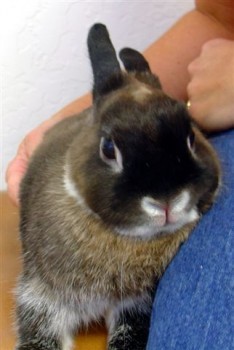
-
House Rabbit Society
- Website: www.rabbit.org
- Description: A comprehensive resource on all aspects of rabbit care, including health, behavior, and adopting rabbits as house pets.
-
The Bunny Guy
- Website: www.thebunnyguy.com
- Description: Offers valuable insights and guidance on rabbit care, with a focus on understanding rabbit behavior and building a strong bond with your pet.
-
Rabbit Welfare Association & Fund (RWAF)
- Website: www.rabbitwelfare.co.uk
- Description: An organization dedicated to promoting the welfare of rabbits, providing resources on rabbit care, diet, and housing.
-
House Rabbit Society's Guide to Litter Training
-
Rabbit.org's Diet Information
- Website: www.rabbit.org/care/diet.html
- Description: Detailed information on the proper diet for rabbits, including hay, fresh greens, and pellets.
-
The Rabbit House
- Website: www.therabbithouse.com
- Description: Offers a variety of resources on rabbit care, including articles on housing, health, and behavior.
-
American Association of House Rabbit Veterinarians (AAHRR)
- Website: www.aahrr.org
- Description: A professional organization of veterinarians specializing in rabbit health, offering resources for finding a rabbit-savvy veterinarian.
-
MediRabbit
- Website: www.medirabbit.com
- Description: Provides in-depth information on rabbit diseases, medications, and veterinary care.
-
BinkyBunny
- Website: www.binkybunny.com
- Description: An online community and resource center for rabbit enthusiasts, offering forums, articles, and a store for rabbit-related products.
-
My House Rabbit
- Website: www.myhouserabbit.com
- Description: A website dedicated to helping rabbit owners create safe and happy indoor environments for their pets.
These resources cover a wide range of topics related to rabbit care, from basic husbandry to specialized medical information. Whether you're a new rabbit owner or an experienced enthusiast, these websites can provide valuable insights and support for your rabbit's well-being.
|
|
|